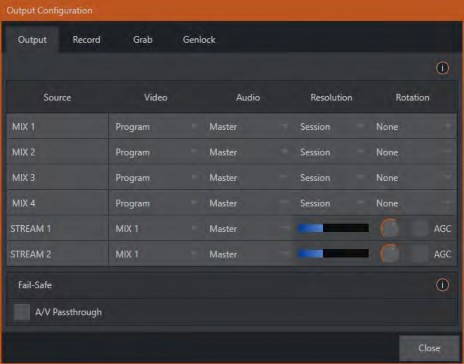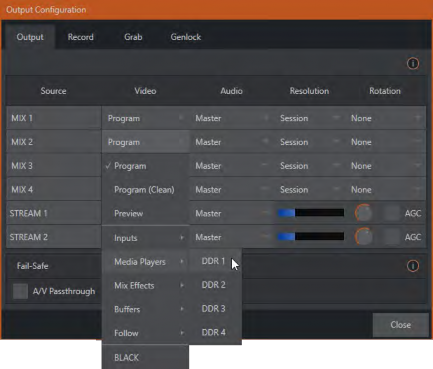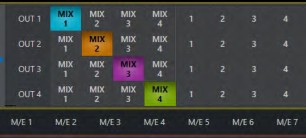
Viz Vectar User Guide
Version 1.0 | Published May 07, 2020 ©
Configuring A/V Output
Primary Outputs
Complete video monitoring is provided right on the Live Desktop in a multiview occupying the upper section of the screen. This lets you operate without even connecting downstream video monitors or devices. (For facilities using NDI-enabled broadcast devices and systems, there would be no necessity to bother with any traditional connections.)
Often you'll want to connect external monitors or other downstream devices to the SDI OUT connectors of the unit (see Output Connections ). In either case, you will be faced with decisions about the output formats, and audio and video sources provided to downstream systems.
The primary ‘mixed a/v outputs are presented to downstream devices by various means as depicted in the following table.
|
|
Video Output |
Audio Output |
||||||||
|
Name |
Source |
Format |
SDI |
NDI |
Source |
SD I |
NDI |
Other |
Master chan. 1, 2 |
Aux chan.1, 2 |
|
Mix 1 |
Selectable |
Selectable |
|
|
Selectable |
|
|
* |
Analog Out 1 |
Analog Out 2 |
|
Mix 2 |
Selectable |
Selectable |
|
|
Selectable |
|
|
* |
Dante DVS 1, 2 |
Dante DVS 1, 2 |
|
Mix 3 |
Selectable |
Selectable |
|
|
Selectable |
|
|
* |
* |
* |
|
Mix 4 |
Selectable |
Selectable |
|
|
Selectable |
|
|
* |
* |
* |
|
Up to eight audio channels can be mapped to supplementary outputs with the installation of supported third-party audio drivers (such as Audinate’s Dante™). |
||||||||||
Let’s take a closer look at output configuration options.

-
Move your mouse pointer to the large Program Output monitor on the Live Desktop.
-
Click the Configure button (gear) that appears at lower right over the viewport to open the Output Configuration panel.
Tip: If you are using a touch interface, tap two fingers together on any viewport to open the corresponding configuration panel.
This panel hosts several tabbed panes, with the first one labeled Output. This is where the signals sent to each of the video output busses designated MIX 1-4 as well as Stream outputs are configured. There are various decisions to make for each output:
-
What video source will you assign to the output?
-
What audio source will accompany it on digital connections that carry both signals?
-
Which video format will be transmitted? And so on …
Tip: Resolution and color adjustments for devices connected to the various monitor ports on the backplane are located in the Display Settings panel, accessible from the Workspaces menu in the main Dashboard.
Output Channel Options
Let’s review video source selection first. A drop-down menu in the Video column permits you to assign sources to the primary video outputs. The primary output connectors are identified by number in the SDI OUT group on the system backplane; these sources also appear on your network as NDI sources.

-
Optional Source selections for MIX output channels include any of the following:
-
Program output
-
A clean Program feed
-
The look ahead Preview
-
The feed from any input
-
Graphic or video output from a Media Player
-
Direct output from any M/E
-
Clean output from any M/E
-
Output from any of the Buffers
-
Follow selected M/E Program or Preview, or a Switcher color group
-
Black
Audio menu options include any of the Master or Aux mixes or the sound from a selected audio input. The Resolution menu lets you independently configure the format for each output.
Note: See Output Configuration for detailed information on all output options.
Supplemental Outputs
The mixed outputs mentioned above are just the tip of the iceberg. Direct support for internet streaming, multiviews, and recorders drastically reduce the need for outputs as they are traditionally defined in this space.
Beyond this, NDI (Network Device Interface) options provide the system with more powerful and plentiful output capabilities than any other video mixer on the market.
Fulltime NDI Outputs
First, in addition to all primary outputs being provided as network sources (NDI), Viz Vectar provides many secondary NDI outputs. Among NDI sources available automatically, without any configuration steps required, over the network are the following:
-
Local SDI sources: All four SDI inputs, if in use (rack-mount systems only).
-
Media Players: The displays from the four Media Players that provide visual output.
-
Buffers: Still image output from all buffers (animated buffers are treated as still frames).
-
Mix 1- 4: The aforementioned mixed Switcher outputs.
NDI Output Matrix Routers
Vectar also provides an additional eight routable NDI outputs, labeled OUT 1-8 on the Live Desktop.

The above image highlights two tabs labeled OUTPUTS 1-4 and 5-8, located at right just above the main Switcher. Clicking a tab reveals one of two specialized crosspoint panels, which appear in the same place that M/E modules are normally shown.

You would not be wrong to think of these panels and their associated NDI outputs as integrated Output Matrix Routers , in that their features are similar to those normally provided by an external SDI matrix router .

We’ll discuss advanced aspects of these internal Output Matrix Routers later (NDI Output Routers). At this point, when discussing configuring your system, note that you can assign many different sources to each of the eight supplemental NDI outputs in these panes. Thus, Output source options occupy three banks like Switcher source rows.